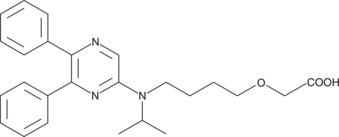Territorial Availability: Available through Bertin Technologies only in France
- Synonyms
- [4-[(5,6-diphenylpyrazinyl)(1-methylethyl)amino]butoxy]-acetic acid
- Correlated keywords
- MRE269 prostaglandins PGI2 IP receptors inflammation NS-304 NS304 agonists vasodilator hypotensive vascular diseases atherosclerosis hypertension analogs potent selective PGs prodrugs
- Product Overview:
Prostacyclin (PGI2) is a potent vasorelaxant and inhibitor of platelet aggregation. It mediates its actions by binding to a specific G protein-coupled receptor, the IP receptor, on the surface of endothelial cells, arterial smooth muscle, and platelets.{4375} The IP receptor also participates in signal transduction of the pain response, cardioprotection, and inflammation.{5018,9805,8508,5466} MRE-269 is the active form of the prodrug NS-304. It is a potent and selective agonist for the human IP receptor with a Ki value of 20 nM.{14998} In contrast to PGI2, which has a half-life of 30 seconds to a few minutes in vivo, plasma concentrations of MRE-269 remain near peak levels for more than eight hours in rats and dogs.{14998} Unlike the PGI2 analogues, beraprost and iloprost, MRE-269 lacks high affinity for the EP3 receptor.{16443} As a result, MRE-269 induces vasodilation equally in large and small pulmonary arteries, whereas vasodilation of small arteries by beraprost and iloprost is reduced via EP3-mediated vasoconstriction.{16443}
Cayman Chemical’s mission is to help make research possible by supplying scientists worldwide with the basic research tools necessary for advancing human and animal health. Our utmost commitment to healthcare researchers is to offer the highest quality products with an affordable pricing policy.
Our scientists are experts in the synthesis, purification, and characterization of biochemicals ranging from small drug-like heterocycles to complex biolipids, fatty acids, and many others. We are also highly skilled in all aspects of assay and antibody development, protein expression, crystallization, and structure determination.
Over the past thirty years, Cayman developed a deep knowledge base in lipid biochemistry, including research involving the arachidonic acid cascade, inositol phosphates, and cannabinoids. This knowledge enabled the production of reagents of exceptional quality for cancer, oxidative injury, epigenetics, neuroscience, inflammation, metabolism, and many additional lines of research.
Our organic and analytical chemists specialize in the rapid development of manufacturing processes and analytical methods to carry out clinical and commercial GMP-API production. Pre-clinical drug discovery efforts are currently underway in the areas of bone restoration and repair, muscular dystrophy, oncology, and inflammation. A separate group of Ph.D.-level scientists are dedicated to offering Hit-to-Lead Discovery and Profiling Services for epigenetic targets. Our knowledgeable chemists can be contracted to perform complete sample analysis for analytes measured by the majority of our assays. We also offer a wide range of analytical services using LC-MS/MS, HPLC, GC, and many other techniques.
Accreditations
ISO/IEC 17025:2005
ISO Guide 34:2009
Cayman is a leader in the field of emerging drugs of abuse, providing high-purity Schedule I-V Controlled Substances to federally-licensed laboratories and qualified academic research institutions for forensic analyses. We are certified by ACLASS Accreditation Services with dual accreditation to ISO/IEC 17025:2005 and ISO Guide 34:2009.





